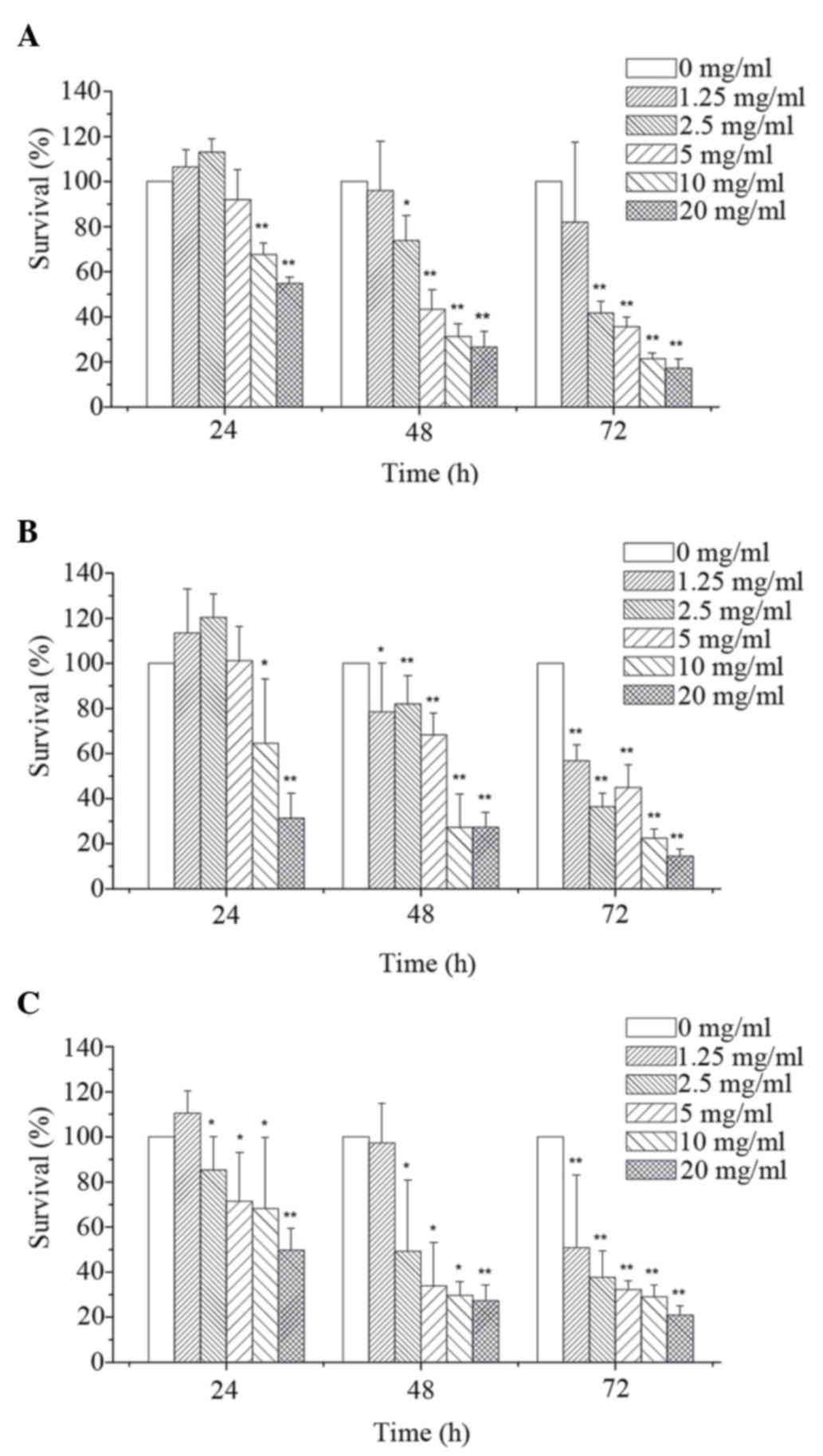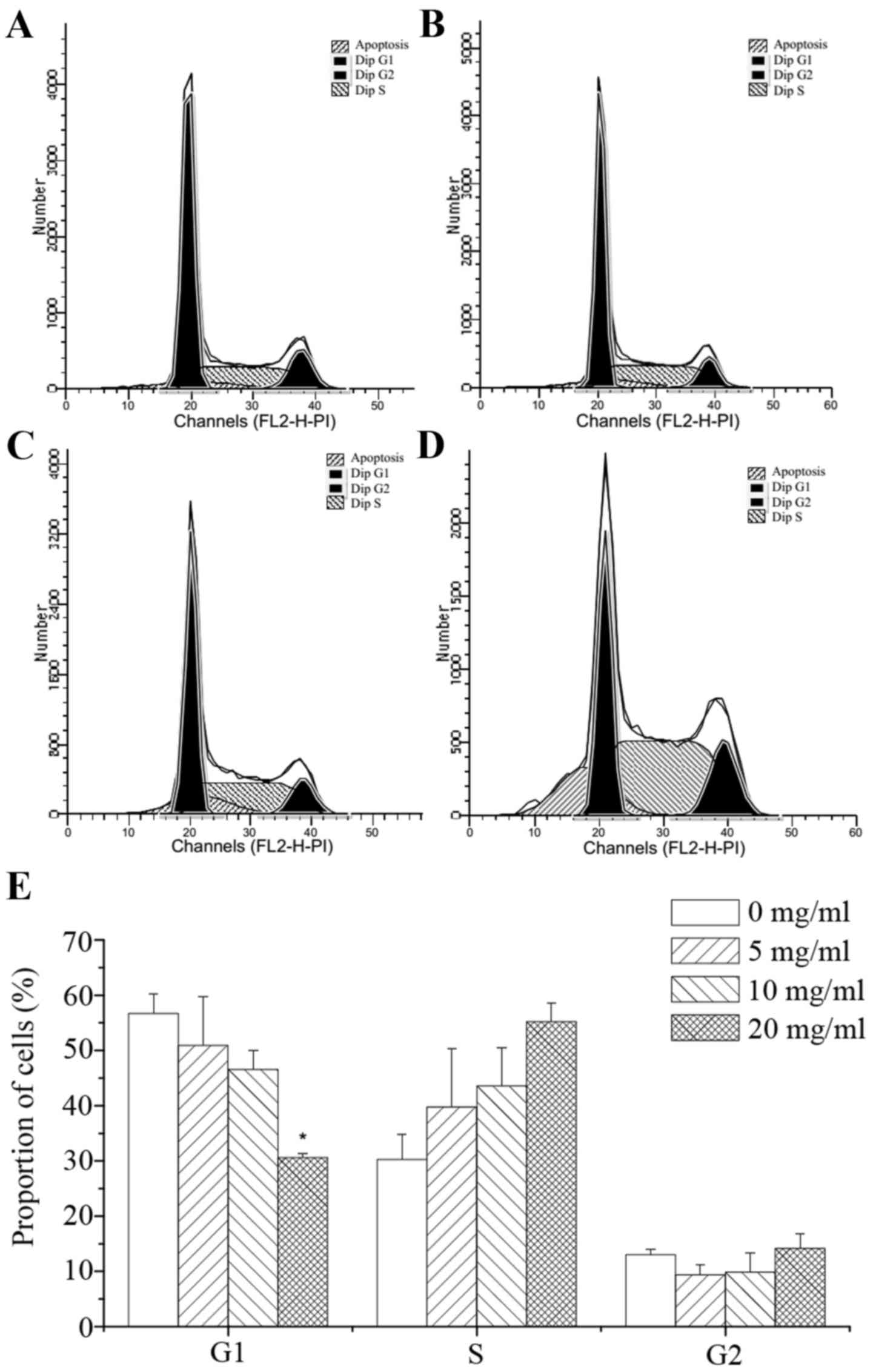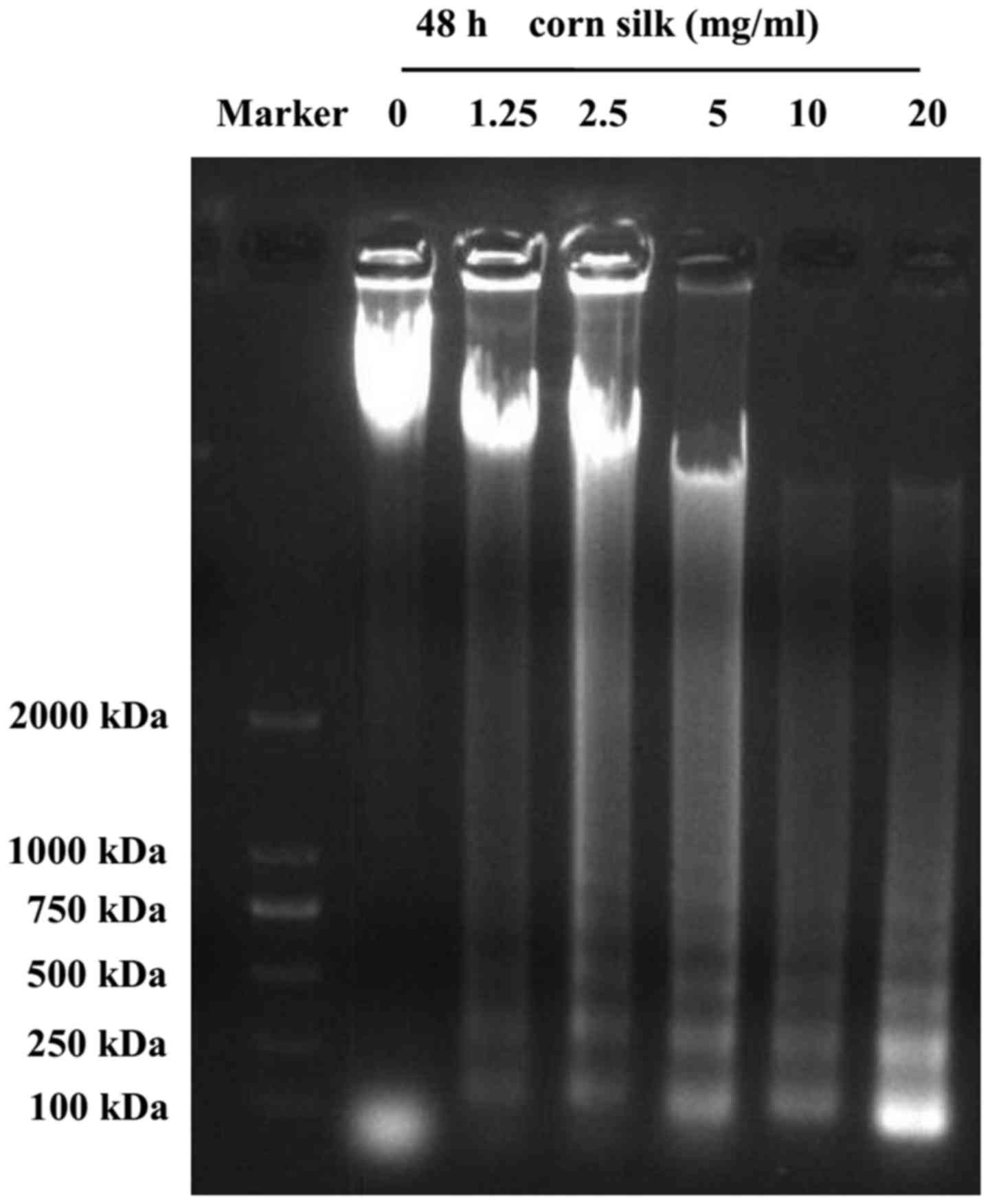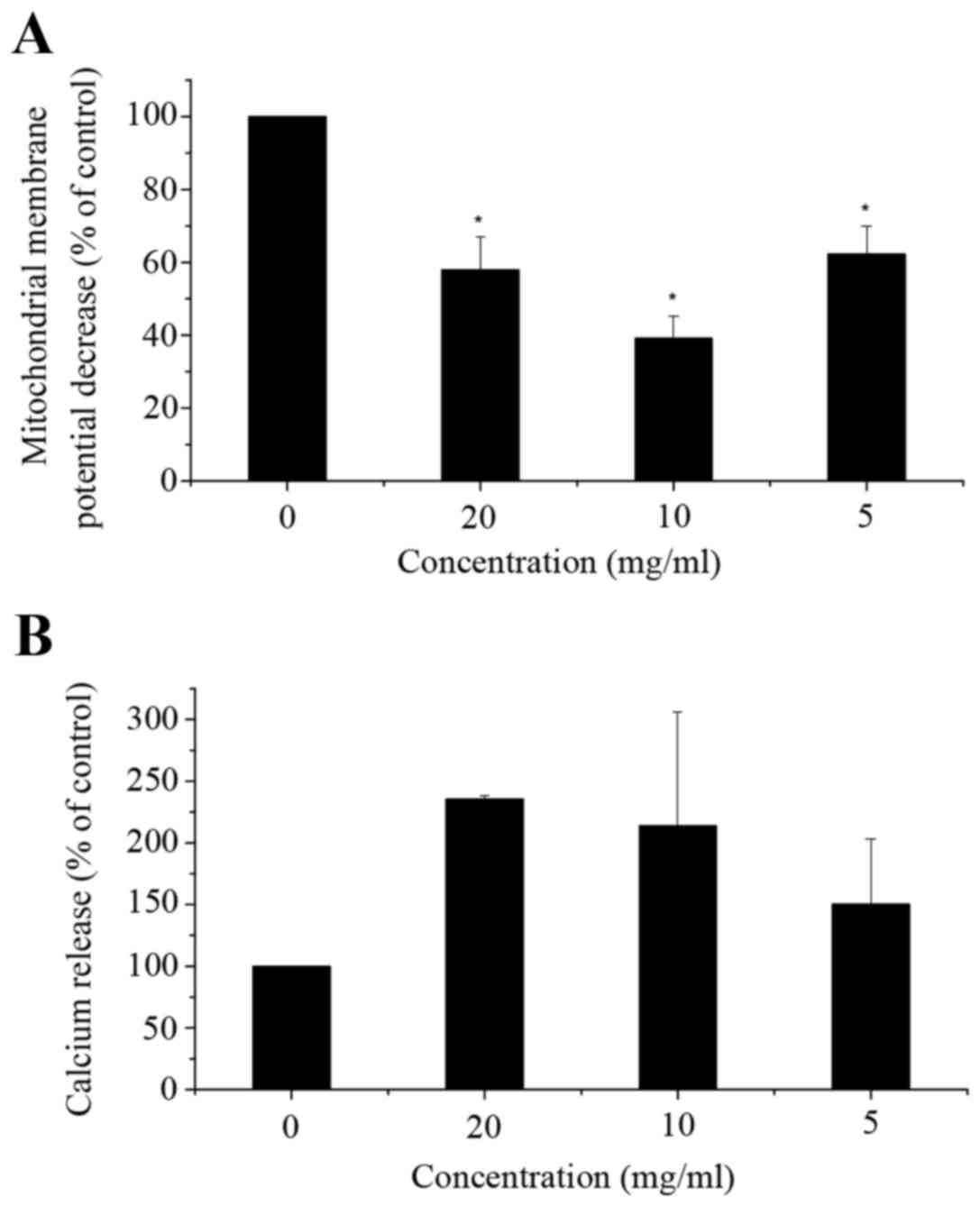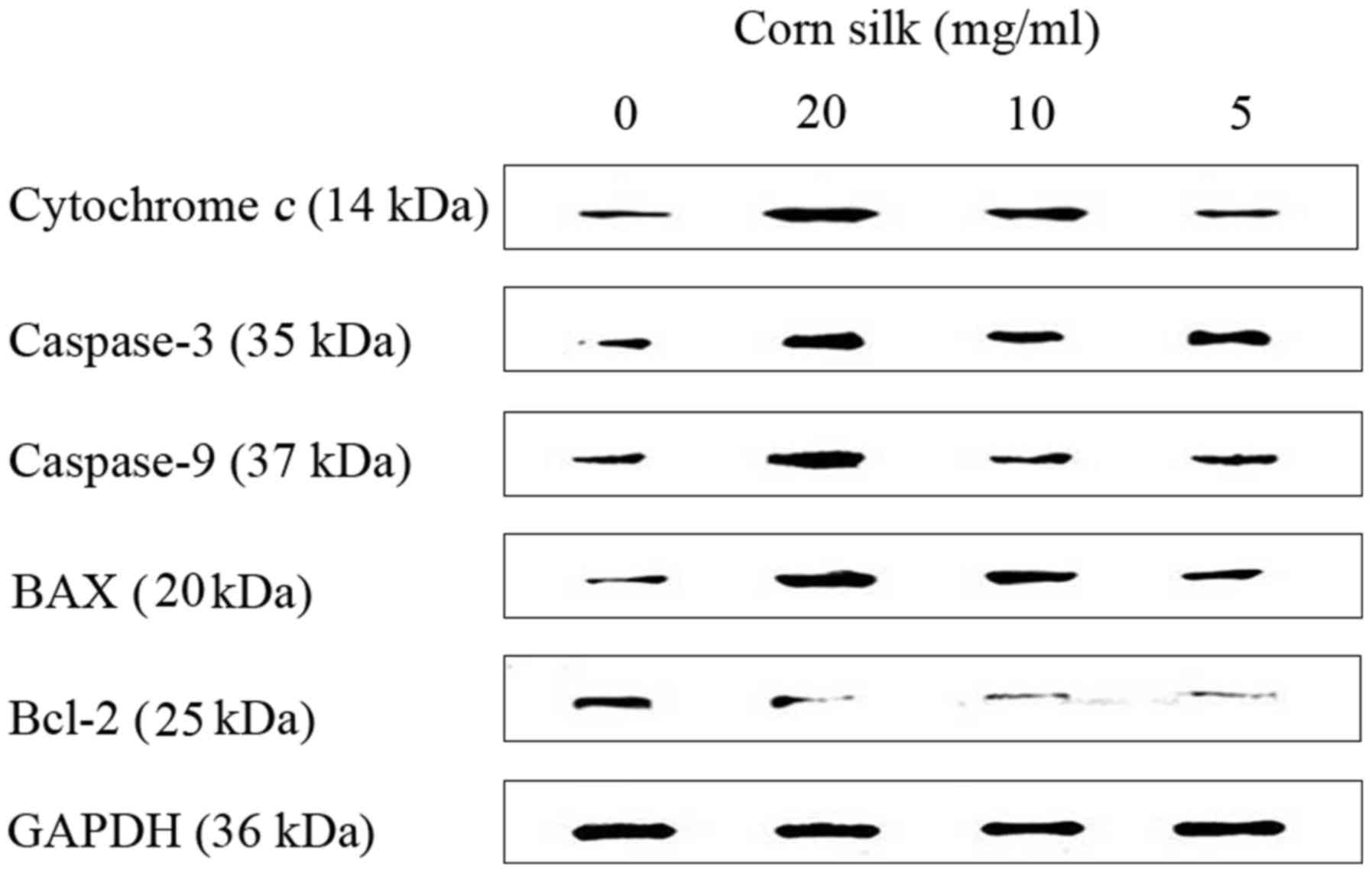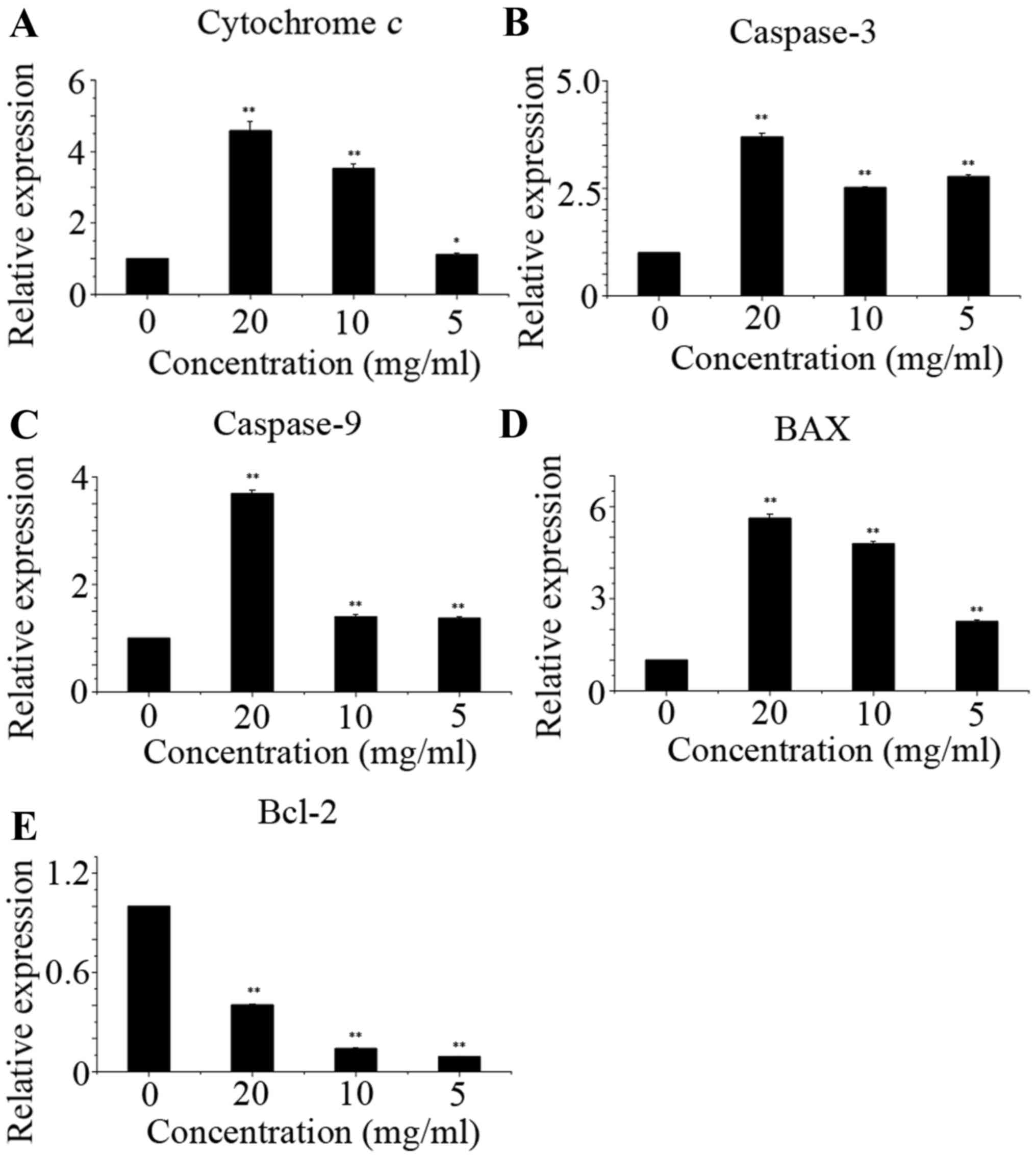Pro-apoptotic and anti-proliferative effects of corn silk extract on human colon cancer cell lines
- Authors:
- Published online on: December 5, 2016 https://doi.org/10.3892/ol.2016.5460
- Pages: 973-978
Abstract
Introduction
Colon cancer is one of the most prevalent cancers throughout the world, and particularly in Western countries (1). There has been an increase in the number of studies aiming to identify novel sources of bioactive compounds that prevent colon cancer. Bioactive compounds of natural origin, particularly from a dietary source, are of significant interest (2).
Plants have a long history of use in the treatment of a number of forms of cancer, and they provide leads for the development of potential novel agents. Corn silk is made from the stigmas and styles of the maize plant belonging to the grass family (3) and it is a well-known traditional functional food and Chinese herbal medicine, which has significant effects on human health (4). It has been reported that consumption of corn silk has no adverse effects and that it is safe for human use. Previous studies have confirmed the presence of multiple bioactive compounds in corn silk, including proteins, polysaccharides (5), flavonoids (6), vitamins, tannins, alkaloids, mineral salts (7) and steroids. There have been numerous studies on the bioactivity of corn silk constituents, including its antitumor capacities (8), anti-diabetic activity in hyperglycemia rats (5) and anti-fatigue activity (9). In our preliminary experiments, corn silk extract was noted to inhibit cell growth and trigger apoptosis (8). However, the specific active ingredients in corn silk extract that induce cancer cell apoptosis remain unknown.
In the present study we investigated whether corn silk extract could induce apoptosis through the mitochondrial pathway in LoVo human colon cancer cells, and whether it could affect cell proliferation, cell cycle progression and protein expression.
Materials and methods
Chemicals and reagents
Collected corn silk was extracted in hot water three times and filtered; the brown filtrate with most of the small soluble compounds was removed. The rest of the corn silk was air-dried and then pulverized into a homogeneous size by a disintegrator. To obtain aqueous extracts, corn silk (500 g per sample) was resuspended in 500 ml 96°C hot water for 1 h at 100°C. Then, the extract was obtained by centrifugation, filtering through a filter paper and cellulose ester membrane with 0.22-µm pores, followed by freeze-drying. Corn silk extract, a light brown powder, was dissolved in Dulbecco's modified Eagle's medium (DMEM), filtered through a 0.22-µm filter and stored at −20°C.
DMEM and RPMI-1640 medium were purchased from Gibco Chemical Co. (Invitrogen Life Technologies, Carlsbad, CA, USA). Fetal bovine serum (FBS), ampicillin sodium and streptomycin sulfate were purchased from Sangon Biological Engineering Technology and Services Co., Ltd. (Shanghai, China). 3-(4,5-dimethylthiazol-2-yl)-2, 5-diphenyl tetrazolium bromide (MTT) was purchased from Amersco (Cleveland, OH, USA). A DNA purification kit was purchased from Promega Corporation (Madison, WI, USA). 3,3′-dihexyloxacarbocyanine (DiOC6) and Fluo-3/AM were purchased from Beyotime Biological Company (Shanghai, China). Antibodies against caspase-3, caspase-9, cytochrome c, B-cell lymphoma 2 (Bcl-2), Bax and goat anti-rabbit IgG were obtained from ComWin Biotechnology Company (Beijing, China).
Corn silk extract composition analysis
The extraction of proteins was determined according to the Kjeldahl method (10); total sugar was determined by the phenol-sulfuric acid assay (11) and reducing sugar by the 3,5-dinitrosalicylic acid (DNS) assay (12).
Cell culture
LoVo and HT-29 human colon cancer cells and MGC-803 human gastric cancer cells were purchased from the Type Culture Collection of the Chinese Academy of Sciences (Shanghai, China). LoVo and MGC-803 cells were cultured in DMEM, and HT-29 cells were cultured in RPMI-1640, containing 10% FBS, ampicillin sodium and streptomycin sulfate. All cells were cultivated under standard conditions at 37°C in a humidified atmosphere containing 5% CO2.
Cell proliferation assay
The effects of corn silk extract on cell proliferation were evaluated by MTT assay. The cells were harvested during the logarithmic growth phase and seeded at a density of 2×104 cells/well in 96-well plates. Following overnight growth, the culture medium was replaced with various concentrations (1.25, 2.5, 5.0, 10.0 and 20.0 mg/ml) of corn silk extract for 24, 48 and 72 h. Approximately 100 µl MTT was added to each well for 4 h. Subsequently, the supernatant was removed and the MTT crystals were dissolved in 200 µl dimethyl sulfoxide. Thereafter, the absorbance was measured at 570 nm using an enzyme-linked immunosorbent assay plate reader.
The 50% inhibitory concentration (IC50) was determined as the anticancer drug concentration causing a 50% reduction in cell viability, and calculated from the cytotoxicity curves. Cell survival (percent) was calculated using the following formula: survival (%) = [(mean experimental absorbance) / (mean control absorbance)] × 100%.
Cell cycle analysis
LoVo cells were seeded in a six-well plate at a density of 5×105 cells/well and treated with various concentrations (5.0, 10.0 and 20.0 mg/ml) of corn silk extract for 48 h. Then, the cells were trypsinized, collected, washed with cold phosphate-buffered saline (PBS) and fixed in 70% ethanol at −20°C overnight. The cells were incubated with RNase A (0.1 mg/ml) and propidium iodide (PI; 50 mg/l) in the dark for 30 min. The cell cycle distribution and the percentage of apoptotic cells (sub-G1 fraction) were determined by flow cytometry (13).
DNA gel electrophoresis
LoVo cells were seeded in a six-well plate at a density of 5×105 cells/well, incubated with various concentrations (1.25, 2.5, 5.0, 10.0 and 20.0 mg/ml) of corn silk extract for 24, 48 and 72 h, and then harvested. The cells were lysed in a cell lysis buffer (10 µmol/ml Tris-HCl, 10 µmol/ml EDTA, 0.5% Triton X-100) at 4°C for 4 min. Following centrifugation, the supernatant was treated with RNase A (20 mg/ml) and proteinase K (20 mg/ml) for 30 min at 37°C. Then, DNA was extracted by NaCl-isopropanol (1:6) at −20°C overnight. The extracted DNA was resuspended and loaded in each well, and DNA gel electrophoresis was performed using 1.5% agarose gel. Following ethidium bromide staining, images of the DNA ladders were captured under UV as previously described (14).
Determination of mitochondrial transmembrane potential (ΔΨm) and Ca2+ levels
LoVo cells were seeded in six-well plates at a density of 2×105 cells/well. Following treatment with various concentrations (5.0, 10.0 and 20.0 mg/ml) of corn silk extract for 48 h, the cells were pelleted by centrifugation for 5 min, washed in cold PBS twice and loaded with specific fluorochromes. For ΔΨm analysis, the cells were resuspended in 0.5 µl DiOC6 (40 µmol/l), incubated at 37°C for 30 min in the dark and analyzed by flow cytometry as previously described (15,16).
To detect Ca2+ release, the cells were resuspended in 1 µl Fluo-3/AM (5 µmol/l) and incubated at 37°C for 30 min in the dark. Following incubation, the cells were washed twice with PBS and analyzed by flow cytometry as previously described (16,17).
Western blot analysis
LoVo cells were seeded in six-well plates at a density of 2×105 cells/well and incubated with various concentrations (5.0, 10.0 and 20.0 mg/ml) of corn silk extract for 48 h. The cells were harvested and extracted using a nuclear and cytoplasmic extraction kit. Then, the proteins were resolved by sodium dodecyl sulphate-polyacrylamide gel electrophoresis. The separated proteins were transferred to polyvinylidene difluoride membranes and blocked with bovine serum albumin blocking buffer for 2 h at room temperature. The membranes were incubated with specific antibodies overnight at 4°C and washed three times with Tris-buffered saline containing 0.1% Tween-20. On the second day, the membranes were incubated with the relevant secondary antibodies (1:2,000) for 90 min at room temperature. Finally, the transferred proteins were visualized using diaminobenzidine as previously described (18,19).
Statistical analysis
All data are presented as the means ± standard deviation of three experiments. Statistical differences between corn silk extract-treated and control groups were evaluated using Student's t-test with SPSS 18.0 (SPSS, Inc., Chicago, IL, USA). P<0.05 was considered to indicate a statistically significant difference.
Results and Discussion
Corn silk extract composition analysis
As shown in Table I, corn silk extract contained 21.80% proteins, 51.70% total sugar and 10.43% reducing sugar (Table I). In a previous study, Ooi and Liu observed that the anticancer activity of polysaccharides may be a consequence of the stimulation of cell-mediated immune response (20). In another study, Yang et al demonstrated that corn silk polysaccharides not only inhibited the tumor growth, but also extended the survival time of H22 tumor-bearing mice (21). Food proteins may be considered as a source of nutraceutical peptides and amino acids that exert biological functions to promote health and prevent disease, including cancer (22).
Effects of corn silk extract on cell proliferation of cancer cells
As shown in Fig. 1, MTT assay revealed that corn silk extract inhibited cell proliferation in a dose- and time-dependent manner. By integrating these data, the 48 h IC50 of corn silk extract on MGC-803 cells (Fig. 1A), HT-29 cells (Fig. 1B) and LoVo cells (Fig. 1C) was 6.09, 5.38 and 4.52 mg/ml, respectively. Compared with the MGC-803 cells and HT-29 cells, LoVo cells were more sensitive to corn silk extract and thus were used to explore the related mechanism of corn silk extract-induced apoptosis in LoVo cells.
Effects of corn silk extract on cell cycle arrest in LoVo cells
PI staining was used to detect the effects of corn silk extract at various concentrations on colon cancer cells. Forty-eight hours after treatment, a sub-diploid peak was present in the left part of the graph. With the increase in corn silk extract concentration, the sub-diploid peak became increasingly evident, representing a gradient of mortality. As shown in Fig. 2A to D, the sub-G1 fractions in the corn silk extract-treated groups were 7.86, 12.93 and 16.44%, which was significantly higher than the 4.71% of the negative control group. These results reveal that corn silk extract has a significant inhibitory effect on cancer cell growth. Moreover, the sub-G1 fraction was increased in a drug concentration-dependent manner. As shown in Fig. 2E, flow cytometry revealed that the percentage of cells in the G1 phase was 56.56, 50.92, 46.57 and 30.62% following treatment with 0, 5, 10 and 20 mg/ml corn silk extract, respectively, for 48 h. The number of S-phase cells was 30.28, 39.72, 43.57 and 55.21% with 0, 5, 10 and 20 mg/ml corn silk extract for 48 h. The data revealed that the relative proportion of cells in the S phase increased when the concentration of corn silk extract was increased. Experiments revealed that the corn silk extract inhibited the proliferation of cells mainly through S-phase arrest, blocking cells from entering the G2/M phase of mitosis. Correspondingly, cells in the sub-G1 phase were also increased in a drug concentration-dependent manner, which was consistent with the flow cytometry data. Therefore, the cell cycle inhibitory effect of the corn silk extract mainly involved S-phase arrest.
Effects of corn silk extract on DNA fragmentation and apoptosis in LoVo cells
As shown in Fig. 3, the formation of the DNA ladder occurred 48 h after treatment with corn silk extract, and this effect was concentration-dependent from 1.25 mg/ml up to a maximum of 20 mg/ml. We observed that, in contrast to the control group, treatment of LoVo cells with corn silk extract for 48 h resulted in internucleosomal DNA fragmentation consisting of 180–200 bp, a characteristic of apoptosis, exhibiting a typical ladder-like pattern of degraded DNA products on agarose gel electrophoresis. A previous study reported that in the event of apoptosis, DNA gel electrophoresis exhibited a clear ladder. DNA gel electrophoresis is considered one of the gold standards in the determination of apoptosis (23).
Effects of corn silk extract on mitochondrial membrane potential and Ca2+ release from LoVo cells
Flow cytometric analysis indicated a significant decrease in mitochondrial membrane potential (ΔΨm) (Fig. 4A) and a significant increase in cytosolic Ca2+ levels (Fig. 4B) in corn silk extract-treated cells when compared with the control cells. As illustrated in Fig. 4A, in LoVo cells exposed to corn silk extract for 48 h, ΔΨm was decreased, particularly in the 10 mg/ml dose group. Cytosolic Ca2+ release increased. As shown in Fig. 4B, cytosolic Ca2+ levels peaked in the 10-mg/ml dose group, with levels being higher than those of the control cells at 48 h. In the mitochondrial apoptosis pathway, the decrease in mitochondrial membrane potential is an early event in apoptosis. It was reported that the proteins extracted from corn silk could decrease mitochondrial membrane potential (22), which is in accordance with our results. However, in the low-dose group, the mitochondrial membrane potential was increased compared with other corn silk extract-treated groups, which may be related to the selection of cells. The elevation of calcium ion levels is associated with signal transduction in the early stages of apoptosis. Mitochondria represent one of the intracellular calcium pools. It was reported that stored Ca2+ was released from the mitochondria, which significantly increased the intracellular calcium level in the early stages of apoptosis (24). This process was synergized by other pro-apoptotic factors leading to apoptosis of a large number of cells. This indicates that corn silk extract could induce apoptosis through the upregulation of intracellular Ca2+ levels. Fan et al reported that the changes of intracellular calcium homeostasis and ΔΨm could contribute to apoptosis in treated cells (23).
Effects of corn silk extract on apoptosis-associated protein expression in LoVo cells
As shown in Fig. 5, corn silk extract upregulated the levels of cytochrome c, caspase-3, caspase-9 and Bax, but reduced the levels of Bcl-2, which led to apoptosis. Western blot analysis data are presented as the relative expression of selected proteins compared with GAPDH (Fig. 6). Using western blot assay, we have shown above that apoptotic pathway induction by corn silk extract treatment was mediated by affecting the Bax and Bcl-2 levels, causing dysfunction of mitochondria, promoting the release of cytochrome c and activating caspase-9 and caspase-3 (15,25).
Caspase is a family of proteases that plays a significant role in the process of apoptosis. Caspase-9 is involved in the upstream stages of the signal transduction cascade of apoptosis. Following the release of cytochrome c from mitochondria, caspase-9 is activated to form a complex with cytochrome c. The activation of caspase-9 then activates caspase-3, thereby facilitating subsequent apoptotic signaling. Caspase-3 is a key enzyme in the apoptotic cascade, playing an essential role in chromatin condensation, DNA fragmentation and other nuclear apoptotic processes (26). This further supports the hypothesis that corn silk extract significantly induced apoptosis in LoVo cells. Bcl-2 family proteins also play crucial roles in apoptosis. This family consists of two types of proteins: anti-apoptotic and pro-apoptotic. It was demonstrated that the change in mitochondrial outer membrane permeability could lead to apoptosis, and this change could be directly mediated by the Bcl-2 family proteins. In addition, the main activity of the Bcl-2 family proteins takes place on the mitochondrial membrane (27). In the present study, the decrease in the Bcl-2/Bax ratio might have led to a decrease in ΔΨm and subsequent activation of caspase-3 via the cytochrome c and caspase-9 pathway. Corn silk extract induced LoVo cell apoptosis features, including nuclear condensation, DNA fragmentation, dysfunction of mitochondria, Ca2+ production and caspase activation.
Based on the results of the present study, it is hypothesized that corn silk extract may inhibit the proliferation of LoVo cells through S-phase arrest, and induce apoptosis through the mitochondria-mediated pathway. At present, the purification of the antitumor components of corn silk extract is in process, which is likely to aid in identifying the mechanisms underlying the antitumor activity of corn silk extract.
Acknowledgements
This study was supported by the Prophase Research Project of Transformation of Scientific and Technological Achievements of Heilongjiang Educational Committee of China under grant no. 1252CGZH04 and the Scientific Research Fund Project of Qiqihar Medical University under grant no. QY2015Q-04.
References
|
Jiang QG, Li TY, Liu DN and Zhang HT: PI3K/Akt pathway involving into apoptosis and invasion in human colon cancer cells LoVo. Mol Biol Rep. 41:3359–3367. 2014. View Article : Google Scholar : PubMed/NCBI | |
|
Patil JR, Murthy KN Chidambara, Jayaprakasha GK, Chetti MB and Patil BS: Bioactive compounds from Mexican lime (Citrus aurantifolia) juice induce apoptosis in human pancreatic cells. J Agric Food Chem. 57:10933–10942. 2009. View Article : Google Scholar : PubMed/NCBI | |
|
Hu QL and Deng ZH: Protective effects of flavonoids from corn silk on oxidative stress induced by exhaustive exercise in mice. Afr J Biotechnol. 10:3163–3167. 2011. View Article : Google Scholar | |
|
Chen S, Chen H, Tian J, Wang Y, Xing L and Wang J: Chemical modification, antioxidant and α-amylase inhibitory activities of corn silk polysaccharides. Carbohydrate polym. 98:428–437. 2013. View Article : Google Scholar | |
|
Zhao W, Yin Y, Yu Z, Liu J and Chen F: Comparison of anti-diabetic effects of polysaccharides from corn silk on normal and hyperglycemia rats. Int J Biol Macromol. 50:1133–1137. 2012. View Article : Google Scholar : PubMed/NCBI | |
|
Liu J and Mori A: Antioxidant and free radical scavenging activities of Gastrodia elata Bl. and Uncaria rhynchophylla (Miq.) Jacks. Neuropharmacology. 31:1287–1298. 1992. View Article : Google Scholar : PubMed/NCBI | |
|
Namba T, Xu H, Kadota S and Hattori M: Inhibition of IgE formation in mice by glycoproteins from corn silk. Phytother Res. 7:227–230. 1993. View Article : Google Scholar | |
|
Habtemariam S: Extract of corn silk (stigma of Zea mays) inhibits the tumour necrosis factor-alpha- and bacterial lipopolysaccharide-induced cell adhesion and ICAM-1 expression. Planta Med. 64:314–318. 1998. View Article : Google Scholar : PubMed/NCBI | |
|
Hu QL, Zhang LJ, Li YN, Ding YJ and Li FL: Purification and anti-fatigue activity of flavonoids from corn silk. Int J Phys Sci. 5:321–326. 2010. | |
|
Lynch JM and Barbano DM: Kjeldahl nitrogen analysis as a reference method for protein determination in dairy products. J AOAC Int. 82:1389–1398. 1999.PubMed/NCBI | |
|
Rover MR, Johnston PA, Lamsal BP and Brown RC: Total water-soluble sugars quantification in bio-oil using the phenol-sulfuric acid assay. J Anal Appl Pyrolysis. 104:194–201. 2013. View Article : Google Scholar | |
|
de Wit JN: Marschall Rhône-Poulenc Award Lecture. Nutritional and functional characteristics of whey proteins in food products. J Dairy Sci. 81:597–608. 1998. View Article : Google Scholar : PubMed/NCBI | |
|
Tai KW, Chou MY, Hu CC, Yang JJ and Chang YC: Induction of apoptosis in KB cells by pingyangmycin. Oral Oncol. 36:242–247. 2000. View Article : Google Scholar : PubMed/NCBI | |
|
Lu HF, Lai TY, Hsia TC, Tang YJ, Yang JS, Chiang JH, Lu CC, Liu CM, Wang HL and Chung JG: Danthron induces DNA damage and inhibits DNA repair gene expressions in GBM 8401 human brain glioblastoma multiforms cells. Neurochem Res. 35:1105–1110. 2010. View Article : Google Scholar : PubMed/NCBI | |
|
Lin SY, Lai WW, Ho CC, Yu FS, Chen GW, Yang JS, Liu KC, Lin ML, Wu PP, Fan MJ and Chung JG: Emodin induces apoptosis of human tongue squamous cancer SCC-4 cells through reactive oxygen species and mitochondria-dependent pathways. Anticancer Res. 29:327–335. 2009.PubMed/NCBI | |
|
Lu HF, Chen YS, Yang JS, Chen JC, Lu KW, Chiu TH, Liu KC, Yeh CC, Chen GW, Lin HJ and Chung JG: Gypenosides induced G0/G1 arrest via inhibition of cyclin E and induction of apoptosis via activation of caspases-3 and −9 in human lung cancer A-549 cells. In Vivo. 22:215–221. 2008.PubMed/NCBI | |
|
Wu CC, Lin JP, Yang JS, Chou ST, Chen SC, Lin YT, Lin HL and Chung JG: Capsaicin induced cell cycle arrest and apoptosis in human esophagus epidermoid carcinoma CE 81T/VGH cells through the elevation of intracellular reactive oxygen species and Ca2+ productions and caspase-3 activation. Mutat Res. 601:71–82. 2006. View Article : Google Scholar : PubMed/NCBI | |
|
Mohan KV, Gunasekaran P, Varalakshmi E, Hara Y and Nagini S: In vitro evaluation of the anticancer effect of lactoferrin and tea polyphenol combination on oral carcinoma cells. Cell Biol Int. 31:599–608. 2007. View Article : Google Scholar : PubMed/NCBI | |
|
Zheng L, Wang X, Luo W, Zhan Y and Zhang Y: Brucine, an effective natural compound derived from nux-vomica, induces G1 phase arrest and apoptosis in LoVo cells. Food Chem Toxicol. 58:332–339. 2013. View Article : Google Scholar : PubMed/NCBI | |
|
Ooi VE and Liu F: Immunomodulation and anti-cancer activity of polysaccharide-protein complexes. Curr Med Chem. 7:715–729. 2000. View Article : Google Scholar : PubMed/NCBI | |
|
Yang J, Li X, Xue Y, Wang N and Liu W: Anti-hepatoma activity and mechanism of corn silk polysaccharides in H22 tumor-bearing mice. Int J Biol Macromol. 64:276–280. 2014. View Article : Google Scholar : PubMed/NCBI | |
|
Lee J, Lee S, Kim SL, Choi JW, Seo JY, Choi DJ and Park YI: Corn silk maysin induces apoptotic cell death in PC-3 prostate cancer cells via mitochondria-dependent pathway. Life Sci. 119:47–55. 2014. View Article : Google Scholar : PubMed/NCBI | |
|
Fan MJ, Lin YC, Shih HD, Yang JS, Liu KC, Yang ST, Lin CY, Wu RS, Yu CS, Ko YC and Chung JG: Crude extracts of Agaricus brasiliensis induce apoptosis in human oral cancer CAL 27 cells through a mitochondria-dependent pathway. In Vivo. 25:355–366. 2011.PubMed/NCBI | |
|
Wang L, Hu T, Shen J, Zhang L, Li LF, Chan RL, Li MX, Wu WK and Cho CH: Miltirone induced mitochondrial dysfunction and ROS-dependent apoptosis in colon cancer cells. Life Sci. 151:224–234. 2016. View Article : Google Scholar : PubMed/NCBI | |
|
Abdel-Latif AM, Abuel-Ela HA and El-Shourbagy SH: Increased caspase-3 and altered expression of apoptosis-associated proteins, Bcl-2 and Bax in lichen planus. Clin Exp Dermatol. 34:390–395. 2009. View Article : Google Scholar : PubMed/NCBI | |
|
Su TR, Tsai FJ, Lin JJ, Huang HH, Chiu CC, Su JH, Yang YT, Chen JY, Wong BS and Wu YJ: Induction of apoptosis by 11-dehydrosinulariolide via mitochondrial dysregulation and ER stress pathways in human melanoma cells. Mar Drugs. 10:1883–1898. 2012. View Article : Google Scholar : PubMed/NCBI | |
|
Wu Z, Liu B, Cailing E, Liu J, Zhang Q, Liu J, Chen N, Chen R and Zhu R: Resveratrol inhibits the proliferation of human melanoma cells by inducing G1/S cell cycle arrest and apoptosis. Mol Med Rep. 11:400–404. 2015.PubMed/NCBI |



